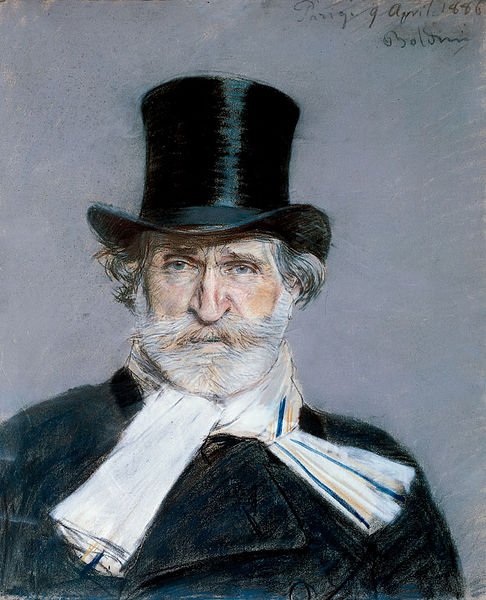Table of Contents
Introduction
In this article I would like to talk to you in the most practical and concise way possible about one of the most influential trilogies of the Italian nineteenth century: the so-called Popular Trilogy, including Rigoletto, Il Trovatore and La Traviata, written by Giuseppe Verdi (1813-1901) over a period of about three years, from 1850 to 1853. Of a typically patriotic and romantic compositional tendency, Verdi took over from the generation of opera composers of his contemporaries (Rossini, Bellini and Donizetti). Considering his very long life (eighty-seven years, almost a record if we consider the average age of composers born in the first half of the nineteenth century), we know that he embodied the ideals of the Risorgimento and represented throughout the nineteenth century the Italian composer, in a nationalistic sense, par excellence: the analogy of the motto Viva Verdi with the acronym V. E. is known in this sense. R. D. I., which was often written as a political slogan to mean “Viva Vittorio Emanuele Re D’Italia”.

Musicologists from all over the world have spoken out about Verdi. A particularly interesting text, written by a great specialist of the author, is Verdi, L’Italiano by Riccardo Muti. You can order it from the banner below at no extra cost: if you do, a small percentage of your purchase will go to support this blog.
Verdi’s Rigoletto – Plot and characters
The first performance of Rigoletto took place in 1851, in Venice. The plot is that of Victor Hugo’s drama entitled Le Roi s’amuse, while the actual libretto is written by Francesco Maria Piave: the only joy in the life of a court jester, is his daughter Gilda (left without a mother). But the Duke of Mantua kidnaps the girl: to take revenge, the buffoon hires a hitman, Sparafucile, to kill the Duke. Gilda, in love with the nobleman, takes his place at the moment of the murderer, dying tragically. Among the most famous pieces of Rigoletto, we remember La Donna È Mobile, the famous aria of the Duke of Mantua in the third (and last) act. You can listen to it below sung by the tenor Luciano Pavarotti:
Verdi’s Il Trovatore – Plot And Characters
The first performance of the drama Il Trovatore dates back to 1853 and took place in Rome, a short distance from that of Rigoletto in Venice. The librettist this time is Salvatore Cammarano, who died in the days following the premiere (Verdi will have to turn to Leone Emanuele Bardare, his collaborator, to request further tweaks and modifications). In four acts, the work follows a particularly articulated plot: the central theme is the love shared by two of the protagonists for the same woman, Leonora. Among the most famous songs of Il Trovatore, we remember Stride La Vampa! which you can listen to below sung by soprano Maria Callas:
Verdi’s La Traviata – Plot And Characters
In the same year of Il Trovatore, 1853, at the same Venetian theater that had seen Rigoletto debut, La Traviata was staged. On a libretto by Francesco Maria Piave, the plot is modeled on the theatrical drama La signora delle camelie by Dumas son and gravitates around Violetta’s love for Alfredo, she sick with tuberculosis and destined to die of this disease in the third act. The very delicate and absolutely new theme at the time made the premiere of La Traviata a real fiasco. Only time has restored to this work the glory it deserves, ascribing it among the immortal masterpieces of opera literature of all time. Among the most famous pieces of La Traviata we remember Libiam Ne’ Lieti Calici that you can listen to below sung by the soprano Maria Callas:
Considering the difficulty of the score of La Traviata, which does not lend itself to compositional insights in a popular article, we remind you that if you want to deepen the musical analysis, there is our special individual online course: you can find the program in the online courses section > the course program, or book an individual lesson online by consulting the availability calendar directly here.
Conclusions
For today’s article we stop here: continue to follow us, in a next page we will continue this very interesting speech, analyzing in detail Verdi scores in the Musical Analysis section. You can subscribe to the e-mail form to not miss the next updates and receive a notification at each new publication: see you in tomorrow’s article!
- History Of The Piano – The Fortepiano - July 12, 2022
- Curt Sachs – History Of Organology At a Glance - July 8, 2022
- Giuseppe Verdi – Rigoletto, Il Trovatore, La Traviata - June 29, 2022
